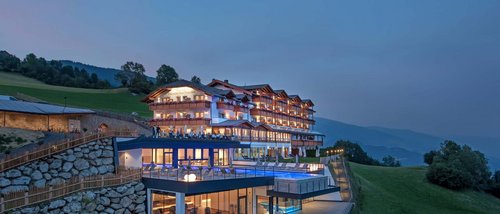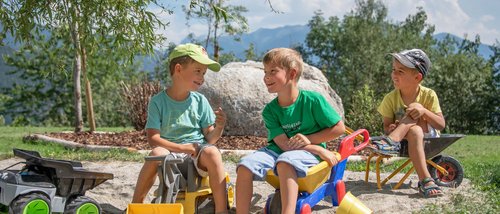South Tyrolean traditions in the Christmas period
From the “Toifl” to Saint Nicholas
Who doesn’t know him? The old man with the red garment and the long white beard.
Santa Claus. No, Nicholas! But what is the sense of this tradition and what do the “Toifl” have to do with it? Read more about in this article.
Who was Nicholas?
Nicholas was a generous man and so famous for his charity that he was declared a saint while he was still alive. Legends report that he calmed a storm and brought several dead people back to life. A famous story is about his help to a poor father with three daughters:
the desperate father is about to send his daughters into prostitution. Nicholas helps here by secretly throwing pieces of gold through the window at night. This is how the myth of the merciful helper and protector was born.
Nicholas was born at the end of the 3rd century and at the age of 19 he was ordained as a pastor by his uncle. Later he became abbot of the monastery of Sion near Myra.
Around the year 350 he died in Myra at the age of 60. His bones were stolen in the 11th century and taken to Bari in Southern Italy, where they are still buried today.
Nicholas face was badly affected by the weather. He had a prominent nose and wore a white beard – but a short one. Its features were reconstructed by scientists years later.
Although Nicholas is considered one of the most revered saints in Christianity, he is also one of the least known. Because there are hardly any reliable facts about his life.
The tradition to send Nicholas to the kids was born in the Middle Ages:
on the Eve of the festival, monastery students elected a “children’s bishop”. The abbot or mayor symbolically gave the power into the hands of the children for a day. The “child bishop’”, dressed in bishop’s robes, “visited” the convent school and reprimanded or rewarded them with sweets.
That is why today the 6th December gifts that are found in their shoes or boots in front of the bed or in in front of the door are brought to the children.
“Toifl” and “Krampus”
In the traditions celebrating Nicholas there are two figures who are considered to be Nicholas’ “evil” companions: Knecht Ruprecht and the “Toifl” or “Krampus”.
As the companion of Nicholas, the Krampus is indispensable in South Tyrol. The 5th December they are on the road all over South Tyrol. However, they are not real devils, but frightening figures that go back to pre-Christian times.
A Krampus is equipped with painted and wood-carved masks and goatskins, which often exude an intoxicating scent. Bells are tied around the belly to make as much noise as possible, and an iron chain is also included. Since the Krampuses were sometimes a little too wild in their activities, everyone who takes part in the different parades as a Krampus is now registered and has to wear a number plate.
The 5th December the Krampus accompanies Nicholas, while the “Toifl” take the part for the naughty children.
Elsewhere, Krampus parades with pyro effects are celebrated long before and after their own Krampus day.
Here you find the calendar for traditional and worth seeing Nicholas and Krampus parades:
Big Krampus parade in Nova Levante
19th November 2022
17th Krampus parade in Valle di Casies
26th November 2022
2nd Krampus parade in Bronzolo
26th November 2022
Krampus parade in Bressanone
5th December 2022
Christmas in Merano: St. Nicholas
6th December 2022
Nicholas parade in S. Michele/Appiano
6th December 2022
Nicholas celebration with ice show in Merano
6th December 2022
Oldest Krampus parade in South Tyrol in Dobbiaco
9th December 2022
Big Krampus meeting in Sesto
10th December 2022
5th “Oachna” Krampus parade in Naz
10th December
Knecht Ruprecht
Knecht Ruprecht is also known as the “evil” companion of Nicholas. Since the 19th century he has not only been the punisher of naughty children, but also a terrifying man designed to scare children. He has a different name, depending on the region: Knecht Ruprecht, “Pulterklas” or “Rupsack”. Instead of a bag of gifts, he usually has a rod with him.
But in the story, he didn’t always play the role of the evil: in the 19th century it was assumed that Nicholas’ assistant could be traced back to pagan rituals: in winter he went out to drive away evil spirits.
Other theories describe him much darker: for example, Knecht Ruprecht is traced back to a priest who is said to have cursed children celebrating and dancing at Christmas in the year 1021.
Others point to an origin in the later Middle Ages, in which the children’s fright was used to support witchcraft prosecutions.
Other pre-Christmas traditions in South Tyrol
4th December Saint Barbara: one of the most important traditions in South Tyrol is in honor of Saint Barbara. On the 4th December fresh cherry twigs are plucked off and freshened up, which are supposed to bloom at Christmas.
13th December Saint Lucia: In honor of Saint Lucia the 13th December everyone celebrates this day differently. Between torch traditions and traditional dishes, lights are lit in honor of Saint Lucia.
Why is it worth knowing these traditions?
The traditions that make us unique are part of our identity. They promote our cohesion and they can be passed on from generation to generation.
The traditions make a big part of the South Tyrolean culture, knowing them helps to experience and understand their culture.
Are you ready for your winter holiday at the Huberhof?
We are open from 17th December and are looking forward to welcome you.
![[Translate to Englisch:] [Translate to Englisch:]](/fileadmin/_processed_/1/4/csm_Markt_in_Brixen_Zeichenfla__che_1_a39aa3c926.jpg)






